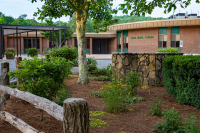Let the tourists return: Smokies’ landslide fixed
Landslide repairs to U.S. 441 through the Great Smoky Mountains National Park were completed early this week — reopening the primary tourist corridor through the park nearly a month ahead of schedule.
U.S. 441 work nears completion
Repairs to U.S. 441 are nearing completion.
A football-field-sized portion of U.S. 441, which runs through the Great Smoky Mountains National Park, was completely washed away in January after days of heavy rain resulted in a landslide.
Jackson revisits development rules along U.S. 441
Jackson County leaders appear to be backing down from a lofty vision to transform U.S. 441 leading to Cherokee into a pedestrian-friendly boulevard.
The planning board has spent several months rewriting commercial development guidelines for the 3.5-mile stretch of highway. The result is billed as a compromise that will give prospective developers more flexibility, yet still require basic aesthetic standards.
Property owners push back against U.S. 441 development regs in Jackson County
A review of rules in Jackson County that guide development along the roughly five-mile stretch of U.S. 441 leading into the Cherokee Indian Reservation is steaming along but possible changes can’t come fast enough for some business owners and residents.
A petition with just fewer than 200 names protesting the current land-use ordinance landed in county commissioners’ laps this month.
David Brooks, a general contractor in the area and one of those who believes the regulations are stifling potential work opportunities, gathered the names contained in the petition. Brooks said this week that doing so was easy — he just drove along the corridor, told people what he was doing and had just one individual opt not to sign her name.
“I started at one end and came to the other,” Brooks said. “The people want it lifted.”
The petition calls on the Jackson County Board of Commissioners “to immediately repeal” the U.S. 441 corridor ordinance adopted in August 2009.
That’s unlikely to happen, however, County Manager Chuck Wooten said.
A task force was appointed last fall to review the development guidelines. It will recommend any changes to planning board, which in turn will recommend changes to county commissioners. The task force has not finished with its review, let alone kicked suggestions up to the planning board yet.
“We are at the very beginning of the review process,” Wooten said.
The development regulations were intended to prevent unsightly or out-of-character sprawl. The current regulations don’t particularly limit where development can occur along the strip of highway leading to Cherokee. It instead lays out aesthetic standards, such as architecture and landscaping, to ensure any development that does occur will be attractive. It also limits billboards and overly large signs, which was a source of contention when it passed.
But property owners believe their options are being limited.
“We believe that the ordinance was adopted with little input from the affected property owners, and that the ordinance causes undue hardship on property owners with the district,” the petition states. “The appearance standards, landscaping rules, and five-acre minimum lot sizes place a burden on property owners and serves to reduce property values for the citizens in this part of Jackson County.”
Pre-made decision?
The Gateway land-use plan was a landmark event when passed five years ago. It marked one of the first attempts by a county west of Buncombe to undertake what is essentially spot zoning.
Commissioner Joe Cowan, who served on the board when the ordinance passed, defended the rules recently as having been developed by people who lived in that community. The Whittier/Gateway community in a series of hearings developed a long-range vision and plan for this critical stretch of four-lane highway.
But, Brooks said in response, “a lot of people think the decision was made before they ever had those public meetings.”
County Planner Gerald Green last fall initiated a planning board based review of the rules. A task force of people who live and work in the corridor are involved in the examination. Green said he believes the group will have recommendations ready for the planning board this spring. Revised regulations likely will make their way for commissioner consideration in the summer.
“We’re moving forward,” Green said, adding that he does not believe goals of protecting the corridor’s character and allowing development are exclusive ones.
Currently, some older motels, a consignment shop, service stations and a few businesses dot the corridor. A couple of art galleries and craft shops are at the nicer end of the spectrum. Businesses catering to tourists are few and far between, but many see the corridor, which has water and sewer, as primed for growth.
Green explained in a previous interview that he believes stipulating “nodes” of concentrated development might actually work better instead of allowing growth to sprawl along the entire strip. Sprawl actually could under-gird, not weaken, another goal of the original plan — traffic management.
Monday, Green said the U.S. 441 subcommittee has indeed identified some potential “nodes.”
Also being reviewed were:
• The section of the rules now in place that dictate any new parking lots go behind buildings, not in front. Green also was concerned that the ordinance failed to stipulate that developers couldn’t just “flip” their new businesses around, with the parking lot facing the highway anyway.
• The possibility of being able to get to several shops from a single access road instead of having a long smear of strip development along the entire corridor. Green has said that discourages pedestrian movement between shops, he added.
“It was designed for flat lands, not the mountains,” Brooks said of the ordinance.
In May, Jackson County residents will vote on whether to allow the sale of alcoholic beverages countywide. In April, Cherokee residents will vote on whether to allow the sale of alcoholic beverages reservation-wide. A “yes” by both or either of those communities is likely to trigger some development along U.S. 441.
“Growth will come, sooner or later, and I do think we need some regulations,” Brooks said, adding that he believes the ones now in place, however, are too restrictive.
Take a gander along the Smokies Scenic byway
The stunning beauty that surrounds U.S. 441 through the Great Smoky Mountains National Park outside Cherokee draws thousands of tourists each year who come to enjoy the cool mountain summers or marvel at the vivid fall foliage along the route.
But come winter, the crowds fall away and a layer of peace and quiet descends over the peaks and valleys — making this season the perfect time to enjoy a serene experience on the state’s newest Scenic Byway.
The 17-mile Smoky Mountain Scenic Byway begins at the foot of the Blue Ridge Parkway outside Cherokee and snakes north through the Great Smoky Mountains National Park until it hits the Tennessee border. Also known as Newfound Gap Road, the byway possesses an abundance of scenic views, historical spots and recreational opportunities to enjoy during the winter months.
The road begins next to the Oconaluftee Visitors Center, open year-round, which features a bookstore and exhibits dedicated to the Great Smoky Mountains National Park. An on-duty park ranger is available here to provide information about the Park and the people who once lived there. Don’t miss the Mountain Farm Museum next door, comprised of pioneer buildings.
A half mile further down the road is Mingus Mill, an 1886 water turbine mill that for more than 50 years ground corn into meal and wheat for the Mingus community.
Past the mill, the byway starts its ascent, eventually climbing a total of about 3,000 feet. The lack of foliage on the trees only serves to enhance the spectacular mountain vistas along the drive, and clearer visibility during the winter months allows visitors to see a further distance than at any other time of year.
Take in the view about 11.5 miles up the road at the Webb Overlook, named for Sen. Charles Webb of North Carolina, a staunch supporter of the park’s establishment. Or journey another two miles up the road to the Oconaluftee Valley Overlook, which boasts spectacular views of the Oconaluftee River Valley below.
The Smoky Mountain Scenic Byway culminates at Newfound Gap, an evergreen spruce-fir forest that straddles the border of North Carolina and Tennessee at an elevation of 5,046 feet. It was here that President Franklin D. Roosevelt officially dedicated the park in 1940. The location is now the site of the Rockefeller Memorial, built to memorialize the support and $5 million donated by the Rockefeller family to help establish the park.
At Newfound Gap, a seven-mile spur road winding up to Clingmans Dome is closed in the winter, but provides a venue for walking and cross-country skiing. Hiking opportunities can also be found at several other points along the byway.
Fewer crowds and bare trees make winter the perfect season to admire the stunning backdrop of the Smoky Mountain Scenic Byway.
This article was written by Julia Merchant, a former reporter at the Smoky Mountain News, who now works as a communications officer for the N.C. Department of Transportation in Raleigh.
Through the park
While U.S. 441 through the Smokies isn’t the official detour around the I-40 rockslide, it could be the best bet depending on where you are heading in Tennessee.
Snow does fall in the Smokies during the winter and sometimes results in road closures. Visitors should check weather and road conditions prior to making the trip by calling the National Park Service hotline at 865.436.1200.
Public weighs in on future of U.S. 441
By Jennifer Garlesky • Staff Writer
Progress on Jackson County’s corridor study for U.S. 441 is taking shape after three public meetings last week.
Youth get a hands-on look at planning their future
By Jennifer Garlesky • Staff Writer
Rachel Upchurch wants to protect the mountains that tower throughout Jackson County however; the Smokey Mountain Elementary student also wants to see more houses and shopping centers built throughout the Qualla community.
441 corridor planning teaches students about smart growth
By Jennifer Garlesky • Staff Writer
Students at Smokey Mountain Elementary and Cherokee Indian Reservation schools will be learning an important lesson about land development.
With formulation of advisory committee, efforts to regulate growth along Hwy. 441 are well underway
By Jennifer Garlesky • Staff Writer
At speeds faster than 50 mph, drivers zoom down U.S. 441 into Cherokee’s business district, passing mostly billboards, a couple of gas stations and a few small businesses. The two-mile stretch of roadway is heavily used by locals and tourists, accommodating about 15,000 cars a day. Some use it to get to the entrance of the Great Smoky Mountains National Park or the Blue Ridge Parkway, others make it their gateway to Harrah’s Casino and downtown Cherokee, while for many it’s just part of their daily driving route.
Cherokee asks for input into corridor planning
By Jennifer Garlesky • Staff Writer
As Jackson County officials work to develop a plan to regulate commercial growth along U.S. 441, officials from the Eastern Band of Cherokee Indians say a partnership needs to be formed to ensure that the area’s economic development fits both parties’ needs.





